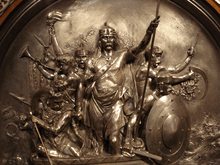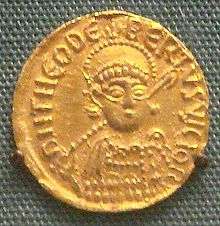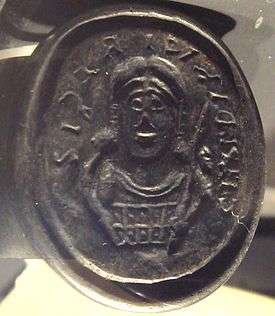Merovech

Merovech (Latin: Meroveus or Merovius) (d. 453/457) is the semi-legendary founder of the Merovingian dynasty of the Salian Franks (although Chlodio may in fact be the founder), which later became the dominant Frankish tribe. His name is close to Marwig, lit. "famed fight" (cf. māri "famous" + wīg "fight"; compare modern Dutch mare "news, rumour" and vermaard "famous").[1] He is said to be one of several barbarian warlords and kings that joined forces with the Roman general Aetius against the Huns under Attila on the Catalaunian fields in Gaul. The first Frankish royal dynasty called themselves Merovingians ("descendants of Meroveus") after him, although no other historical evidence exists that Merovech ever lived.
Evidence for existence
There is little information about him in the later histories of the Franks. Gregory of Tours only names him once as the father of Childeric I while putting doubt on his descent from Chlodio.[2] Many admit today that this formulation finds its explanation in a legend reported by Fredegar.[3] The Chronicle of Fredegar interpolated on this reference by Gregory by adding Merovech was the son of the queen, Chlodio's wife; but his father was a sea-god, bestea Neptuni.[4] Some researchers have noted that Merovech, the Frankish chieftain, may have been the namesake of a certain god or demigod honored by the Franks prior to their conversion to Christianity.
Clodio, the sometime putative father of Merovech, is said to have been defeated by Flavius Aëtius at Vicus Helena in Artois in 448. Ian S. Wood would therefore place his son somewhere in the second half of the fifth century.[5]
It has been suggested Merovech refers to, or is reminiscent of, the Dutch river Merwede,[6] Although this river was historically a main subsidiary of the Rhine, in modern times it is a tributary of the Rhine-Meuse-Scheldt delta; the area where, according to Roman historians, the Salian Franks once dwelled.
Another theory[7] considers this legend to be the creation of a mythological past needed to back up the fast-rising Frankish rule in Western Europe.
Reference in popular culture
The legend about Merovech's conception was adapted in 1982 by authors Henry Lincoln and Richard Leigh in their book The Holy Blood and the Holy Grail, as the seed of a new idea. They hypothesized that this "descended from a fish" legend was actually referring to the concept that the Merovingian line had married into the bloodline of Jesus Christ, since the symbol for early Christians had also been a fish. This theory, with no other basis than Lincoln and Leigh's hypothesis, was further popularized in 2003 via Dan Brown's bestselling novel, The Da Vinci Code.[8][9]
See also
Notes
- ↑ Green, D.H. Language and History in the Early Germanic World. Cambridge, England: Cambridge University Press, 1998.
- ↑ Gregory of Tours - The History of the Franks, II.9
- ↑ Christian Settipani - Addenda to Les Ancêtres de Charlemagne, 1990
- ↑ Pseudo-Fredegar, Hist. III, 9.
- ↑ Wood, Ian. The Merovingian Kingdoms 450 - 751, Pearson Education Ltd., 1994 ISBN 9781317871163
- ↑ Emil Rückert: Oberon von Mons und die Pipine von Nivella; Weidmann'sche Buchhandlung, Leipzig, Germany. 1836
- ↑ see M. Todd's, The Early Germans
- ↑ Behind the Da Vinci Code, 2006, History Channel documentary about Henry Lincoln
- ↑ Holy Blood Holy Grail, Michael Baigent, Richard Leigh, Henry Lincoln, 1982
References
- Behind the Da Vinci Code, 2006, History Channel documentary about Henry Lincoln
- Todd, M. The Early Germans
- Wood, Ian. The Merovingian Kingdoms 450–751. London: Longman Group, 1994.
External links
-
 Media related to Merovech at Wikimedia Commons
Media related to Merovech at Wikimedia Commons

